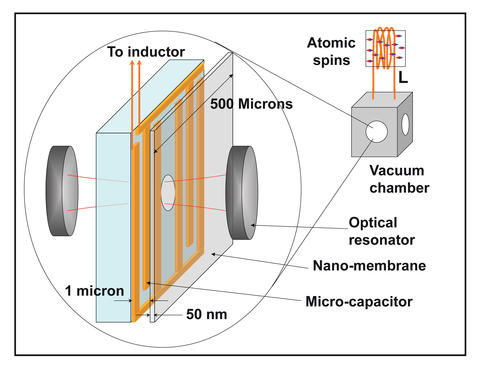
JQI researchers think they have discovered a way to amplify faint electrical signals using the motion of a nanomechanical membrane, or loudspeaker. If shown in experiments, the scheme could prove a boon to magnetic resonance imaging and quantum information science. This schematic of the proposed device shows its use in detecting--in this example--a signal produced by the quantum-mechanical "spin" of a group of atoms. The atoms generate a faint radiofrequency signal in a coil (L) which is connected to microscale wires that form an electrical capacitor. This vibrates the 'nanomembrane' which in turn affects the resonant frequency of a laser optical cavity. The output is light at frequency that is the sum of the original laser frequency plus the signal from the atoms.
A team of physicists from the Joint Quantum Institute (JQI), the Neils Bohr Institute in Copenhagen, Denmark, and Harvard University has developed a theory describing how to both detect weak electrical signals and cool electrical circuits using light and something very like a nanosized loudspeaker.* If demonstrated through experiment, the work could have a tremendous impact on detection of low-power radio signals, magnetic resonance imaging (MRI), and the developing field of quantum information science.
The JQI is a collaborative venture of the National Institute of Standards and Technology (NIST) and the University of Maryland, College Park.
"We envision coupling a nanomechanical membrane to an electrical circuit so that an electrical signal, even if exceedingly faint, will cause the membrane to quiver slightly as a function of the strength of that signal," says JQI physicist Jake Taylor. "We can then bounce photons from a laser off that membrane and read the signal by measuring the modulation of the reflected light as it is shifted by the motion of the membrane. This leads to a change in the wavelength of the light."
Present technology for measuring the wavelength of light is highly sensitive, which makes it ideal for detecting the nanoscopic motions of the loudspeaker caused by extremely faint electrical signals.
And the ability to detect extremely faint electrical signals may someday make MRI medical procedures much easier.
"MRI machines are so big because they are stuffed with really powerful superconducting magnets, but if we can reduce the strength of the signals we need for a reading, we can reduce the strength, and the size, of the magnets," Taylor says. "This may mean that one could get an MRI while sitting quietly in a room and forgo the tube."
The same setup could be used to generate information-carrying photons from one qubit to another, according to Taylor.
One popular quantum information system design uses light to transfer information among qubits, entangled particles that will exploit the inherent weirdness of quantum phenomena to perform certain calculations impossible for current computers. The 'nanospeaker' could be used to translate low-energy signals from a quantum processor to optical photons, where they can be detected and transmitted from one qubit to another.
All this, and the team will throw in cooling the system for free. According to their calculations, translating the mechanical motion of the little loudspeaker into photons will siphon a considerable amount of heat out of the system (from room temperature to 3 kelvin or -270 C), which in turn will reduce noise in the system and provide for better signal detection.
* J. M. Taylor, A. S. Sørensen, C. M. Marcus and E. S. Polzik. Laser cooling and optical detection of excitations in a LC electrical circuit. Phys. Rev. Lett. 107, 273601. Published online Dec. 27, 2011. http://link.aps.org/doi/10.1103/PhysRevLett.107.273601

